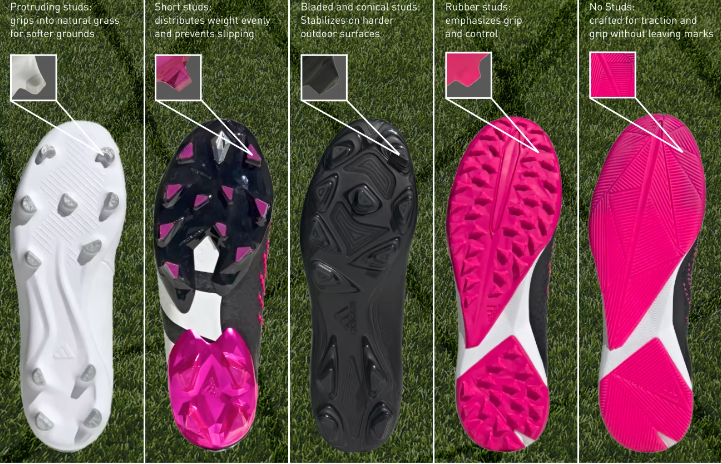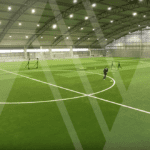- Last Updated -
The 5 Different Types of Soccer Cleats: Explained
When it comes to playing soccer, the type of cleats you wear is a critical factor that can make all the difference in your game. There are five different types of soccer cleats, each designed for specific playing conditions and surfaces.
Understanding these soccer cleat types is an essential part of ensuring that you perform at your best on the field. The first type of soccer cleat is hard-ground soccer cleats.
As the name suggests, these cleats are designed for use on dry and firm surfaces such as concrete or asphalt. Hard-ground soccer cleats come with shorter studs that provide excellent traction on dry surfaces while allowing you to move faster and change direction quickly.
All-ground soccer cleats are another type of soccer shoe designed for use on various surfaces such as natural grass or artificial turf. All ground soccer shoes have a combination of short and long studs that make them versatile enough to be used in any weather condition and surface type.
These are perfect for players who play in multiple leagues or positions. Firm-ground soccer cleats are specifically designed for use on natural grass fields with firm soil conditions.
These types of shoes feature a series of bladed studs or conical shapes that offer excellent traction while running, stopping, or changing direction on natural grass fields. Soft ground Soccer Cleats are perfect for wet grassy conditions where maximum grip is required due to their longer blades which provide excellent traction when running at high speeds, making them ideal for strikers and wingers who require maximum acceleration when dribbling past opponents.
Artificial Ground Soccer Cleats were specifically created for artificial turf surfaces where traditional screw-in studs may cause injury or damage the surface itself. They typically contain rubberized soles with small nubs fused into their construction which provides additional traction without damaging the turf surface.
Understanding Soccer Cleat Types based on different playing conditions is critical in choosing the right pair of boots before heading out to play a game whether it’s Indoor Soccer Shoes, Turf Soccer Cleats, or Soccer Shoes. Depending on your position and the type of players you’re up against, choosing the right soccer cleats can give you an added advantage and help you perform better in-game situations.

Hard Ground Soccer Cleats
When it comes to soccer, having the right pair of soccer cleats is essential for a player’s performance on the field. With so many different types of soccer cleats available in the market, it can be tough to know where to start.
One type that players might consider are hard-ground soccer cleats. are designed for surfaces that are extremely firm and dry.
They offer great traction and stability on hard surfaces, but they might not be suitable for other types of fields. have a large number of small studs that are evenly distributed across the soleplate, which helps to distribute weight and provide a good grip on compacted surfaces.
These types of soccer cleats are popular among midfielders who spend a lot of time running up and down the field. They’re also suitable for forwards who need quick acceleration and sharp turns while playing on firm grounds as well as defenders who need good stability while making quick lateral movements.
It’s important to note that hard-ground soccer cleats might not perform well in wet conditions or on artificial turf fields. In those cases, a different type of soccer shoe might be more appropriate.
However, if you’re playing on a hard ground field under dry conditions, then these shoes can give you the advantage you need to make an impact during a game. In addition, some brands offer variations within hard ground cleat models such as those with built-in cushioning or wider than normal soles for people with wider feet.
It is important to try out different pairs before deciding which ones work best for you as every player’s feet have unique needs when it comes to footwear. Overall, hard ground soccer cleats should be considered by players looking for maximum traction and stability on firm grounds with dry conditions but don’t forget there are also other Soccer Cleat Types catered towards different positions or field requirements such as Soft Ground Soccer Cleats or Turf Soccer Cleats depending on play style.
All Ground Soccer Cleats
are a versatile type of cleat that can be used on most surfaces. They are made with a combination of rubber and plastic studs or blades that provide traction on different surfaces.
AG soccer cleats are a popular choice among players who play on different types of playing surfaces, such as synthetic and natural grass. One advantage of all ground soccer cleats is their adaptability to different field conditions.
They work well on hard ground, firm ground, and artificial turf. They have a combination of small and medium-sized studs that allow for quick turns and acceleration while still providing stability during lateral movements.
This makes them ideal for players who frequently switch between playing on different types of fields. Another great advantage of all-ground soccer cleats is their durability.
Since they can be used on multiple types of surfaces, they tend to last longer than other types of soccer shoes since you don’t need to switch out your shoes every time you play on a new type of surface. When it comes to choosing the right all-ground soccer cleat for you, there are a few things to consider such as your position and style of play.
Midfielders tend to prefer these shoes because they often cover the most ground during the game and need an adaptable shoe that can handle various surfaces. Forwards also benefit from all-ground soccer cleats because they require speed and agility in their movements.
If you’re looking for an affordable yet high-quality option, consider Adidas Performance Men’s Copa 17.4 FG Soccer Shoe or PUMA Men’s Evospeed SL H2H FG Soccer Shoe which are both great options depending upon your preferences and position requirements. Overall, All-Ground Soccer Cleats offer versatility, durability, lightweight fit as well as support which could make them the ideal choice for many players depending upon their style and position requirements.
Firm Ground Soccer Cleats
If you plan on playing soccer on a typical grass field, firm-ground (FG) soccer cleats are your best bet.
These are the most common type of soccer cleats and they’re designed for dry, natural grass fields. Most players will find that firm-ground soccer cleats are the best choice for most games.
have an average amount of studs with medium length to provide stability and traction on the normal, dry surface of a grass field. The studs are usually conical and evenly spaced across the sole plate to ensure that weight is distributed evenly across your foot.
This design allows for quick turns, sudden stops, and acceleration during play without sacrificing stability or comfort. There’s a wide variety of firm ground soccer cleats available with varying levels of support, cushioning, and flexibility features.
Some have additional padding or extra stud patterns to enhance ball control while others may offer increased arch support or be specifically designed for players who need more ankle support. When choosing firm ground soccer cleats, consider your position on the field as well as your personal preferences.
Certain positions such as forwards may prefer lighter shoes with more flexibility while defenders might require thicker soles with better shock absorption. Overall, Firm Ground Soccer Cleats are suitable for most players because they work well in various weather conditions including damp grass fields.
They provide just enough traction and support without being too overwhelming which makes them perfect for recreational leagues as well as professional matches. It’s essential to know which type of soccer cleat is best suited for a particular playing surface before purchasing anything.
FG Soccer Cleat Types excel at providing comfortable traction and balance during play on natural grass fields. So if you’re looking for an all-purpose pair of shoes that you can use in most situations then Firm Ground Soccer Shoes could be exactly what you need!
Soft Ground Soccer Cleats
are normally used for games that are played in wet and muddy conditions. The primary purpose of this type of soccer cleat is to provide the players with a better grip on soft or wet ground, which would otherwise make them slip and slide around.
have studs that are longer and more widely spaced than those of other types of soccer shoes. As a result, they can penetrate the muddy surface and give players more stability, preventing injuries.
One thing to note about soft-ground soccer cleats is that they’re not suitable for every surface. They’re designed specifically for use on natural grass pitches that have been affected by rain or other weather conditions.
If you’re playing on an artificial turf field or any other hard surface, it’s better to opt for a different type of soccer cleat. When it comes to choosing soft ground soccer cleats, there are several factors you should consider.
First, think about your position on the field. Strikers need lightweight boots with good traction and ball control, while defenders require durable boots with ankle support and lateral stability.
Second, consider your playing style – if you tend to exert a lot of pressure with your movements during games, then you’ll need a sturdier pair. When shopping for soft-ground soccer cleats, be sure to check out all the different brands available on the market today.
There are countless options out there from top-tier brands like Adidas and Nike down to less expensive options from lesser-known brands – but don’t let price be your only deciding factor! You may find that spending a little extra money upfront will lead to greater comfort and performance in the long run!
Artificial Ground Soccer Cleats
are specifically designed for playing on artificial turf.
They have shorter studs or nubs compared to other types of soccer cleats, which is necessary because longer studs may get caught in the artificial grass and lead to injuries. These shorter studs or nubs provide good traction on the turf without damaging it, which is why they are the most popular type of soccer cleats for playing on artificial surfaces.
When choosing an artificial ground soccer cleat, players must look for shoes that offer good support and stability. Since synthetic fields tend to be harder than natural grass, shoes with good cushioning are also important to absorb shocks while running, jumping, and making quick movements.
Most artificial ground soccer cleats feature a flat sole plate with a lot of small rubber lugs or chevron-shaped studs that provide traction without causing damage to the surface. The outsoles of these shoes usually have a triangular shape that allows players to make quick turns and sudden stops with ease.
Players should keep in mind that while these types of soccer cleats work well on synthetic turf fields made from materials like Astroturf or FieldTurf, they may not perform as well on other types of surfaces. It’s always best to check with the field manager before wearing them on any surface other than an artificial one.
Overall, artificial ground soccer cleats offer excellent support and comfort during gameplay on synthetic turf surfaces. They are perfect for players who frequently play in such conditions and want a specific shoe designed for it.
How to Choose the Right Soccer Cleats
When it comes to choosing the right soccer cleats, there are a few factors to consider. First, you need to look at the playing surface. Are you playing on hard ground, soft ground, or an artificial surface?
Each type of surface requires a different type of cleat. For example, if you’re playing on hard ground, you need soccer cleats with short studs that will provide better traction and stability.
Another factor to consider when choosing the right soccer cleats is your position on the field. Different positions require different types of soccer cleats.
For example, forwards need lightweight and agile cleats that can help them make quick movements and changes in direction. On the other hand, defenders need more durable and sturdy cleats that can withstand tackles and other physical challenges.
Your foot shape is also important when choosing the right soccer cleats. Some types of soccer cleats are designed for narrow feet while others are designed for wider feet.
It’s important to find a pair of soccer shoes that fit your foot shape comfortably to avoid injuries or discomfort while playing. Budget can be an important factor when choosing the right soccer cleat types for you.
Soccer shoes can range from inexpensive indoor soccer shoes to premium turf soccer cleats priced at hundreds of dollars per pair. Remember that investing in quality and durable Soccer Cleat Types that fit well will prevent injuries down the road.
When it comes to how to choose the right soccer cleats, there are many factors at play including playing surface, position on the field, foot shape and size considerations as well as budget constraints. Make sure you take these factors into account before making your final decision on what type of soccer shoe fits your needs best!
Comparison of Different Soccer Cleats
When it comes to choosing the right soccer cleats for your game, it’s essential to look at all of the different types and compare them. Each type of soccer cleat has its own unique set of features that make them better suited for different situations and types of players. In this section, we’ll take a closer look at the comparison of different soccer cleats to help you make an informed decision.
First up are hard-ground soccer cleats. These are made for playing on very hard surfaces, such as artificial turf or other man-made surfaces.
They have short studs that provide good traction on these hard surfaces without getting too stuck in the ground. Hard-ground soccer cleats are great for players who play on these surfaces regularly or those who need a shoe with more durability.
Next, we have firm ground (FG) soccer cleats. These are made for natural grass fields that aren’t too wet or slippery.
They have longer studs than hard-ground soccer cleats which provide better traction in soft grass without getting stuck in the mud. Firm ground soccer cleats are great for most outdoor games because they give you a good balance between grip and control.
If you play on a variety of surfaces and aren’t sure what type of field you’ll be playing on next, then an all-ground (AG) soccer cleat might be right for you! All-ground soccer shoes are designed to work well on both firm natural grass fields and artificial turf fields, so they’re quite versatile.
Soft ground (SG) soccer shoes are made with longer studs that provide excellent traction in muddy or wet conditions. These shoes work well when there’s heavy rain or if your field is particularly soft and muddy from lots of use.
There are artificial ground (AG) turf shoes designed specifically for use on artificial turf fields like those found in indoor arenas or multi-use facilities like schools or parks. Turf Soccer Cleats feature small rubber nubs or bumps on the sole that provide excellent traction on these types of surfaces.
There are many Soccer Cleat Types to consider when choosing the right soccer cleats for your game. All ground, Firm ground, Soft ground, and Turf Soccer Cleats have their unique strengths and weaknesses.
When comparing different soccer cleats, it’s important to consider your play style and the type of field you’ll be playing on to make an informed decision. With this information in mind, you can narrow down your options and choose the perfect pair of soccer shoes for your needs!
Pros and cons of each type of soccer cleat
When it comes to choosing the type of soccer cleat that’s right for you, it’s important to weigh the pros and cons of each option. Here are some things to consider:
Hard Ground Soccer Cleats: These cleats are designed for use on hard, dry surfaces. They feature fewer studs than other types of soccer cleats, which can provide better traction on hard ground.
However, because they have fewer studs, they may not provide as much stability or support as other types of cleats. Additionally, if you try to use these on softer ground or wet fields, you might find yourself slipping and sliding all over the place.
All Ground Soccer Cleats: As their name suggests, these cleats are versatile enough to be used on a variety of surfaces. They typically have a medium number of studs and can be used on both firm and soft ground.
While they may not excel in either environment compared to more specialized options, they offer a good balance between versatility and performance. Firm Ground Soccer Cleats: These are arguably the most common type of soccer cleat out there.
Firm ground soccer cleats usually feature molded round studs that work well on short-grass fields where conditions aren’t too wet or too dry. They tend to perform well across different positions and playing styles and come in a wide range of designs.
Soft Ground Soccer Cleats: Soft ground soccer cleats are designed for use on muddy or wet fields where traction may be an issue. These shoes typically feature longer conical or metal studs that offer greater grip in slippery conditions but may sink into harder surfaces like turf or concrete.
Artificial Ground Soccer Cleats: As turf fields become more popular around the country, so do artificial ground soccer shoes. These shoes feature shorter rubber nubs instead of traditional metal spikes which makes them more suitable for synthetic grass surfaces than traditional soccer boots with spikes would be.
Ultimately the type of soccer shoe you choose will depend on various factors, including your position and playing style, as well as the environment in which you play. Consider these pros and cons when deciding on the right soccer cleat for you.


See best of soccer cleat articles below

Situational examples of when to use each type
It’s important for soccer players to understand the different types of soccer cleats and when to use them. The right pair of cleats can make a huge difference in your game, so it’s important to choose wisely based on the surface you’ll be playing on and your playing style.
First up, we have hard-ground soccer cleats. These are ideal for playing on hard surfaces like artificial turf or indoor courts.
They’re designed with smaller studs that provide better traction on these types of surfaces without causing too much damage to the surface itself. If you’re a player who spends a lot of time playing indoor or futsal soccer, these would be a great option for you.
Next, we have all ground soccer cleats. As the name suggests, they’re versatile enough to work well on different types of surfaces including firm and soft ground.
These are a great option if you play on multiple surfaces and don’t want to invest in several pairs of shoes. You can also wear all-ground soccer shoes for different positions as they offer good support and traction.
Firm-ground soccer cleats are designed specifically for natural grass fields that are well-maintained and not too wet or muddy. They have longer studs that provide more grip in the grass but can cause damage if used on harder surfaces like concrete or artificial turf.
Soft-ground soccer cleats have longer studs than firm-ground ones which makes them perfect for wet or muddy natural grass fields by providing more stability while running around despite muddy terrain. artificial Ground Soccer Cleats are purposely designed with shorter synthetic blades that help navigate through fake-grass pitches while providing immense control over your footing which is necessary when making quick turns.
We have artificial ground soccer cleats which are ideal for playing on artificial turf or any other type of synthetic surface as they feature rubber outsole plates with numerous small nubs and grooves that help provide extra traction without damaging the court surface itself. The type of soccer cleats you choose is important and should be based on the surface you’ll be playing on as well as your playing style.
By understanding the different types of soccer cleats available and when to use them, you can improve your game and reduce your risk of injury. Whether you prefer hard ground, all ground, firm ground, soft ground, or artificial ground soccer shoes for players in different positions or Soccer Cleat Types, there’s a perfect pair out there waiting for you!
Quick Takeaway: Choosing the Right Soccer Cleat for Your Game
Choosing the Right Soccer Cleat for Your Game When it comes to choosing the right soccer cleat for your game, there are several factors to consider. The surface you will be playing on, your position on the field, and your personal preference all come into play.
But one thing is certain: having the right pair of soccer cleats can make a big difference in how you perform on the field. If you’re playing on firm ground, then firm-ground soccer cleats are a must.
They provide good traction on dry natural grass surfaces and are designed for players who like to make quick cuts and changes of direction. However, if you’re playing on soft ground or in wet conditions, then soft-ground soccer cleats might be a better option.
They have longer studs that can penetrate soft surfaces and provide better traction. The type of player you also affect which soccer cleats would be best for you.
Forwards typically need lightweight and agile soccer cleats that allow them to move quickly and make sharp turns. Midfielders need versatile soccer cleats that can handle both offensive and defensive play.
Defenders require durable soccer cleats that provide good support and protection from hard tackles. Some positions may require specific types of soccer cleats as well.
For example, goalkeepers often opt for indoor soccer shoes or turf soccer cleats because they spend most of their time in one area of the field and don’t need as much traction as players in other positions. Ultimately, it’s important to try out different types of soccer cleats and choose the ones that feel most comfortable to you.
Don’t be afraid to invest in high-quality shoes that will last through multiple seasons – it could end up saving you money in the long run. Selecting the right type of soccer shoe is crucial for performance on the field depending upon specific conditions such as surface hardness or softness as well as personal preferences according to one’s role and playing style.
Soccer shoes that offer good traction, support, durability, and fit are key to improving your game. By taking the time to research different types of soccer cleats and trying out various brands, you can find the perfect pair that will help you dominate on the field.
FAQs
When it comes to choosing the right soccer cleats, players can easily get confused by the different types of soccer cleats available on the market. There are five main types of soccer cleats: hard ground, all ground, firm ground, soft ground, and artificial ground.
Each type has its unique features and is designed for specific conditions. Artificial Ground
Artificial ground soccer cleats are specifically designed for playing on synthetic surfaces such as turf or artificial grass. These types of fields are becoming increasingly popular in many parts of the world because they require less maintenance compared to natural grass fields.
Artificial ground soccer cleats usually have short rubber studs that provide better traction on turf surfaces while still allowing players to make quick turns and sudden stops. Soccer Cleats for Different Positions
Another factor to consider when choosing the right type of soccer cleat is player position. Different positions require different levels of support and traction from their footwear.
For example, goalkeepers need more support around their ankles than midfielders because they need to be able to dive and jump without injuring themselves. Attackers, on the other hand, need soccer shoes with excellent grip and mobility so that they can make quick changes in direction and speed.
Firm Ground Firm ground soccer cleats are suitable for playing on natural grass fields that are well-maintained and dry.
These types of fields offer good traction for players who prefer a firm surface underfoot. Firm ground soccer shoes usually come with conical or bladed studs that provide excellent grip on dry natural grass surfaces.
Indoor Soccer Shoes If you’re planning on playing indoor or futsal football games, then indoor soccer shoes would be your best bet as they have flat soles that provide better traction and control on smooth surfaces such as hardwood floors or synthetic court surfaces.
When it comes to choosing the right type of soccer shoe for your game, there are several factors to consider, including playing surface, player position, and personal preference. By understanding the different types of soccer cleats available, you can make an informed decision on which type will offer you the best performance on the pitch.
What are the different cleats for soccer?
Soccer cleats are the most important gear for any soccer player. They provide the necessary traction and support to a player’s foot while playing on a field. There are different types of soccer cleats as manufacturers design them keeping in mind various playing surfaces, player positions, and weather conditions.
The most common type of soccer cleat is the firm ground (FG) soccer cleat. These are designed for use on natural grass fields with dry and firm ground conditions.
FG soccer shoes have a combination of conical studs and bladed studs that provide excellent traction and stability while playing on the grass. Another type of soccer cleat is all-ground or multi-ground cleats, which can be used on various surfaces such as artificial turf, natural grass, or hard ground.
All-ground shoes are versatile and suitable for players who play on different surfaces regularly. Soccer players who play on soft or wet grounds should consider getting soft ground (SG) shoes.
Soft ground shoes have longer studs that penetrate the ground more deeply to provide better traction in wet conditions. For players who often play indoors or on hard court surfaces, indoor soccer shoes are ideal.
These shoes typically have flat rubber soles that provide grip without damaging the surface. There are turf soccer cleats designed specifically for artificial turf surfaces.
They feature shorter studs than traditional FG cleats and do not penetrate the surface as much as SG shoes do. Turf cleats help prevent injuries from slipping while playing on synthetic fields.
Choosing the right pair of soccer shoes is crucial to ensure optimal performance during a game while also preventing injuries. Aspiring to excel in this sport requires being mindful of your position requirements & understanding which Soccer Cleat Types best suits your needs according to your field type & condition
What are the 3 levels of soccer cleats?
When it comes to soccer cleats, there are generally three levels of quality: Entry-level, Mid-level, and High-end. Each level has its unique characteristics and is meant for different types of players. Entry-level soccer cleats are designed for beginner players who are just starting out in the game.
These cleats often have a lower price point and may not have as many advanced features as their higher-end counterparts. They are typically made with synthetic materials and feature a basic design.
Entry-level soccer cleats are perfect for young players who are growing quickly and will need to replace their shoes frequently. Mid-level soccer cleats offer more advanced features than entry-level cleats but aren’t quite as high-end as top-of-the-line models.
They tend to be more durable than entry-level shoes and may have additional padding or support in key areas of the foot. Mid-level soccer cleats can be a great option for experienced players who want a comfortable shoe that won’t break the bank.
High-end soccer cleats are designed for serious players who demand the best performance from their shoes. These shoes often use premium materials like leather and feature advanced features like stud patterns that can be customized based on field conditions.
High-end soccer cleats tend to be more expensive than entry-level or mid-range options, but they’re worth it if you’re serious about your game. When choosing between different levels of soccer shoes, consider your skill level, playing style, and budget.
If you’re just starting in the game or don’t play frequently, an entry-level shoe may suffice. However, if you’re an experienced player looking to take your game to the next level, investing in mid-range or high-end Soccer Cleat Types can help improve your performance on the field.
In addition to considering the different levels of Soccer Shoes, it’s also important to choose the right type of shoe for your position on the field. For example, defenders often opt for firm ground soccer cleats for added traction and stability, while attackers may prefer softer ground soccer cleats for better control and mobility.
Goalkeepers typically wear turf soccer cleats, which offer a balance of traction and flexibility on artificial ground surfaces. By choosing the right type of soccer cleat for your position and skill level, you can optimize your performance on the field and take your game to the next level.
Are there different types of cleats?
There are certainly different types of soccer cleats to choose from. The type of cleat you choose can depend on several factors, including the playing surface, your position on the field, and your personal preferences. One popular type of soccer cleat is the firm ground soccer cleat.
These are designed for use on natural grass surfaces that are not too wet or too dry. They usually have short studs or blades that provide good traction and stability, without sinking too deeply into the ground.
Another type of soccer cleat is the soft-ground soccer cleat. These are designed for use on wetter or softer natural grass fields.
They typically have longer studs or blades that can penetrate deeper into the ground to provide better traction and stability. Some players may prefer all-ground soccer cleats, which are versatile enough to be used on a variety of playing surfaces.
These typically feature a hybrid stud pattern that includes both shorter and longer studs, giving them decent traction on both firm and soft surfaces. Then there are turf soccer cleats, which are designed specifically for artificial turf playing surfaces.
These usually have shorter rubber studs or nubs that help prevent slipping without damaging the turf. Of course, there are many other types of soccer shoes available as well, including indoor soccer shoes for playing on gym floors or indoor arenas.
Ultimately, choosing the right type of soccer cleat comes down to personal preference and practicality. Consider where you’ll be playing most often – hard ground?
Soft ground? Artificial turf?
– as well as any specific needs you might have based on your position or style of play. By doing some research into different Soccer Cleat Types ahead of time and trying out different options in person if possible, you can make an informed decision about which pair will best suit your needs out on the field!
What does FG stand for in cleats?
If you’ve been shopping for soccer cleats, you might have seen the abbreviation FG next to some of the products. But what does FG stand for? Well, it simply stands for Firm Ground.
Firm Ground soccer cleats are designed to be worn on natural grass fields that are firm and dry. They have molded studs that offer excellent traction and stability on firm surfaces.
In other words, they’re perfect for most outdoor soccer fields that aren’t too muddy or wet. One thing to note is that not all Firm Ground cleats are created equal.
Some are designed specifically for players in certain positions, such as strikers or defenders. For example, strikers might benefit from cleats with a more aggressive stud pattern that allows for quick acceleration and sharp turns, while defenders might prefer cleats with a wider base and more durable construction.
Firm Ground soccer cleats are also often used as all-purpose cleats by many players because they can work well on a variety of surfaces (except very soft or hard surfaces). However, if you play on artificial turf or indoor surfaces frequently, then these types of soccer cleats might not be the best fit for your needs.
Instead, you may want to opt for Turf Soccer Cleats or Indoor Soccer Shoes respectively. In short, if you’re playing mostly on natural grass fields that aren’t too soggy or muddy, then Firm Ground Soccer Shoes will likely be the best option in terms of providing stability and traction underfoot – just make sure to choose a pair based on your position and playing style!
Conclusion
Choosing the right type of soccer cleats can make a huge difference in your game.
Different types of players, fields, and positions require different types of soccer cleats to ensure maximum performance and safety. Understanding the differences between soccer cleat types is vital to choosing the right pair for you.
For players who frequently play on hard ground, hard-ground soccer cleats are a must-have. With their short rubber studs, they provide excellent traction while minimizing slipping and sliding on dry fields.
Soft-ground soccer cleats are best suited for players who often play on wet or muddy fields. Their longer spikes provide better penetration into soft surfaces for improved stability.
All-ground soccer cleats are great all-around options that work well on both firm and soft surfaces with their combination of short and long spikes. Firm ground soccer cleats are engineered for use on grassy pitches or artificial turf with molded studs that provide excellent grip without damaging the playing surface.
Artificial ground soccer cleats are designed specifically for synthetic turf fields as they have shorter studs that prevent sinking into the infill material. They also have a flat soleplate which allows for better contact with the surface.
When it comes down to it, purchasing a pair of reliable soccer shoes will give you an advantage in your game no matter what type you end up choosing! With so many options available today in terms of construction materials, style preferences, and even team colors – finding just one perfect pair may take some time but is worth it in terms of both performance improvement and personal style statement!
Soccer Substitution Rules: The Strategic Art of Changing the Game
Soccer, known as the beautiful game worldwide, has seen various changes to...
Read More


















